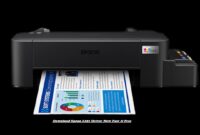Printing Photos with the Epson L455: Tips and Tricks-Epson L455 is part of the renowned EcoTank series, which is renowned for its cost effective and high quality printing. This all-in-one ink tank system printer features wireless connectivity for seamless printing from different devices. Its key features include vibrant colour reproduction, high resolution and the ability to handle a variety of paper types. Its photo printing capabilities make it an attractive choice for enthusiasts who want to create stunning prints from their digital images.

The world of digital photography has changed the way we share our memories. Despite the convenience of storing photos on smartphones or cloud-based platforms, many still value the tangible and timeless appeal of printed photos. The Epson L455 multifunctional printer has gained popularity for its exceptional photo printing capabilities. To get the best results and preserve the essence of those captured moments, here are some valuable tips and tricks for photo printing with the Epson L455.
Epson L455 Choosing the right paper Printer
Choosing the right paper is crucial to achieving the desired print quality. For photo printing, it’s best to use Epson Premium Glossy Photo Paper or other high quality photo papers designed specifically for inkjet printers. These papers are formulated to absorb ink effectively, enhance colour vibrancy and produce sharp, detailed images. Paper weight and finish also play an important role in the final output, so choose 200 gsm or more for a more professional look.
Epson L455 Optimise image resolution Printer
Before printing, it’s important to ensure that the image resolution matches the intended print size. Higher resolution images contain more pixels, resulting in clearer, more detailed prints. For best results, it’s best to use images with a resolution of at least 300 dots per inch (DPI) at the size they will be printed. This avoids pixelation and maintains the quality of the printed photo.
Using Epson L455 printer settings
The Epson L455 offers various settings to customise the print quality and achieve the desired output. Use the printer’s settings to adjust colour saturation, brightness and contrast to suit the specific characteristics of the photo. In the printer software, select the highest print quality and appropriate paper type to ensure accurate ink distribution and optimal colour reproduction. Next, Experiment with different settings to find the best combination for your photos printer.
Calibrate colour profiles
Colour calibration is essential for accurate colour reproduction. The Epson L455, like many modern printers, offers colour management settings to adjust colour profiles. Calibrating the printer with the monitor’s colour settings ensures that the printed photo matches what you see on the screen. This process minimises colour discrepancies and helps to produce lifelike prints.
Printer maintenance Epson L455
Proper printer maintenance is essential for consistent, high-quality photo printing. Regularly clean the print heads and check the nozzles to prevent clogging and ensure smooth ink flow. Keep the printer in a dust-free environment and store paper in a cool, dry place to prevent paper jams and maintain paper quality.
Epson L455 Printing test photos
Before printing a large number of photos, it’s a good idea to print a test photo. This will allow you to assess the colours, sharpness and overall quality before committing to a full print run. If necessary, adjust the settings to achieve the desired output.
Conclusion Epson L455 Printer
Printing photos with the Epson L455 can be a rewarding experience if the right techniques are used. By choosing the right paper, optimising image resolution, using the printer’s settings, calibrating colour profiles, maintaining the printer and making test prints, you can produce remarkable photo prints that capture the essence of the moments you have captured. Experimentation and practice will ultimately help you master the art of printing stunning photos with the Epson L455. Embark on the journey of transforming digital images into tangible, cherished memories.


